Sitara Cariapa's The Drunken Pig Instagram page and food blog archives her grandmother’s traditional Coorgi cuisine.
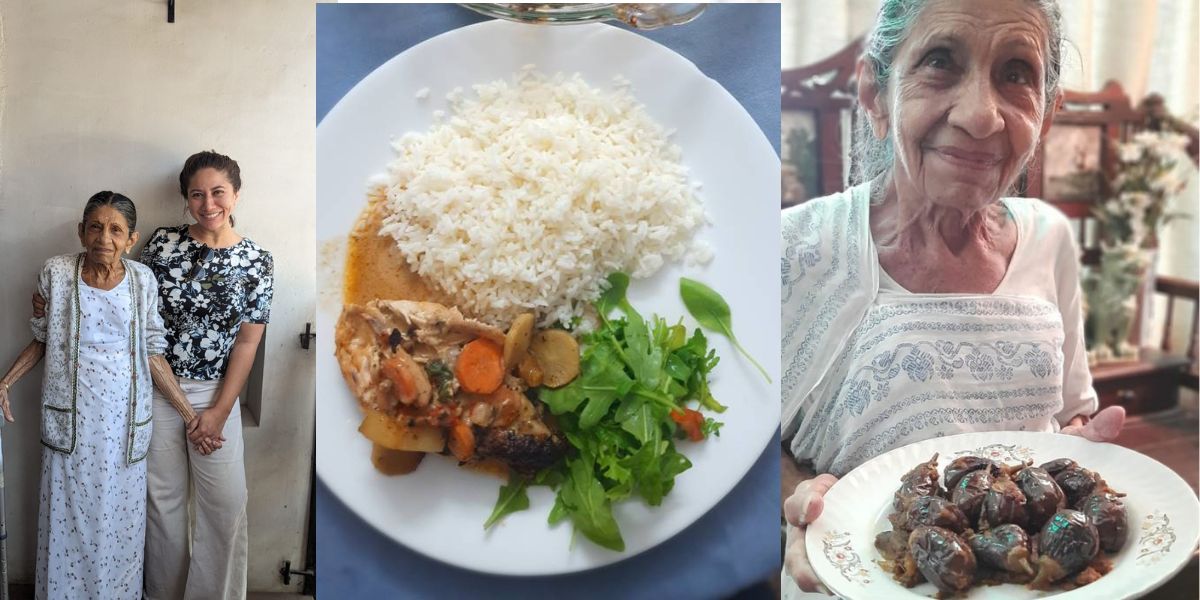
During the pandemic, Cariappa would sit with her grandmother for hours as she told her stories about foraging in the olden times in Coorg. (Sitara Cariappa)
For Kodavas — an indigenous tribe native to the steep mountains of Coorg in the southern state of Karnataka — kachampuli can make or break a meat dish. Also known as Garcinia gummi gutta, it is a black vinegar liquid made from the fruit panpuli.
“Just two to five drops are more than enough when using kachampuli in cooking. Because its pungency is extremely high, we use a teaspoon of it while preparing a kilo of meat, for instance,” explains Sitara Cariappa, a proud member of the Kodava community.
“Long ago, Kodavas used to carry rice on the back of oxen to Kerala and trade that for salt, dry fish, or coconut oil through the barter system,” adds Cariappa, who has us hooked with yet another trivia about cuisine of the Kodavas.
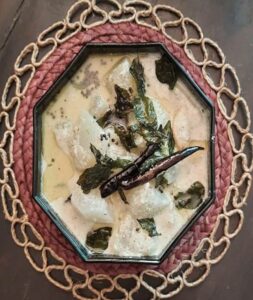
Boodhi kumbala curry (Sitara Cariappa)
“In the British era, traders from the Mysuru region started coming to Kodagu (anglicised as Coorg) once a month. They brought red chili, onions, garlic, and jaggery, to name a few. My maternal grandmother tells me that they also brought different pulses and sesame seeds and traded these for paddy from Kodagu,” says Cariappa.
Her blog, titled The Drunken Pig, documents many such nostalgic, yet lesser-known stories from the hilly region.
“The Drunken Pig was a name that I coined in connection with my alcohol-based meat recipes,” the epicure remembers.
“Between 2016 and 2019, I cooked meat, especially pork, with alcohol or marinated it with whiskey or beer. I was living in Coorg at the time and had plenty of access to fresh, homegrown ingredients that I used extensively to marinate meat with. The people of Coorg love meat and are known to make their own liquors, wines, and spirits at home,” she explains.
Initially, she started an Instagram page to post photos of her meals. These were mostly dishes that Cariappa learnt from her travels across Europe and Asia. The website was started two years later in 2018.
Sharing stories and recipes from Coorg has only been a recent feature on both platforms.
“During the pandemic, I would sit with my grandmother, Lakshmi Ganapathy, for hours as she told her stories about foraging in the olden times in Coorg, cooking in large quantities for her joint family, preserving techniques and vegetable gardening. All of this came in extremely handy and I found it worthy of sharing with everyone,” she adds.
While Cariappa was born in Virajpet, Coorg, she grew up in New Delhi. But her parents ensured Cariappa and her siblings stayed in touch with their roots.
“All Kodava, no matter where they live, have the urge to connect with other fellow Kodavas in and around your city (cook traditional Kodava food and share, participate or indulge in cultural activities and keep in touch with relatives back home),” quips Cariappa, who has a degree in Psychology.
She runs the blog remotely from Delhi, but visits Coorg quite frequently.
“In our Delhi home, if anyone drops in at any time, they will surely get to eat a Kodava meal with us,” she says. Add to this the fact that her family is filled with members who are food enthusiasts.
“My father is the biggest foodie I know. He worked with a Korean company and then a French one. Growing up, we were exposed to eating with Koreans and the French, which meant learning to eat with metal chopsticks, drinking barley water, and so on.”
Cariappa first took to cooking when she was 11. “It happened after I started watching the cooking show, Urban Peasant, hosted by James Barber. In my adult life, living alone in Singapore and France helped me develop my cooking and dining skills further,” she says.
The blogger has worked in consulting and HR globally for 11 years. She also has an MBA from France.
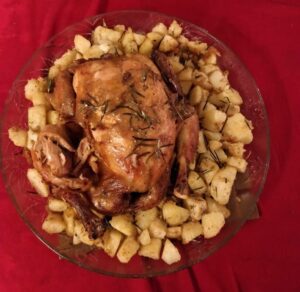
French roast chicken served with buttered rice. (Sitara Cariappa)
“When I started my blog, my go-to dishes were drunken pork shoulder lump and ribs, pork chops with chili oil, Thai chicken curry, and Naga chicken with bamboo shoot,” she recalls.
But today, the dishes she cooks are more homely and Kodava-specific.
What is so special about the cuisine and culture of Kodavas?
Kodavas were traditionally agro-pastoral in nature, they relied solely on mixed farming techniques as a means of livelihood, that is in agriculture and raising livestock, Cariappa details.
“They were also hunters-gatherers, actively obtaining everything by foraging whatever grew and was available around them. For instance, vegetarian cuisine of Kodavas is largely seasonal. In the monsoon, we gather colocasia (khembh), fiddlehead fern (thermé thopp), wild ground mushrooms, wild tree mushrooms, and bamboo shoots (baimbalé) to name a few,” she says.
In the earlier times, Kodavas also hunted wild boar (kaad pandhi), deer, porcupine (mul pandhi), and cooked dishes with them, she adds.
“While some food influences from foreign settlers in Kodagu have come in much later, the cuisine always remained native to what we made since the pre-British era,” she adds.
On her blog, The Drunken Pig, Cariappa doesn’t forget to mention the Kodava meals she and her siblings grew up eating. Accompanied by stellar photos, she even posts detailed recipes of these mouth-watering meals.
Some of her all-time favourites are baimbale otti (bamboo shoot curry with rice flat bread) or pandi curry (pork curry), paputt koli curry (steamed rice thari cakes with chicken curry), kori erachi curry (mutton curry), and pork chuddals (woodfire grilled pork).
Snacks include olige (like the puran poli) and koovalé-putt (also called koolé-putt; is made with ripe jackfruit pulp and rice thari mixed with coconut shavings and then wrapped in banana leaves or koovalé leaves. These parcels are then steamed to set and eaten with ghee).
Cariappa’s culinary experiments are also documented in Quarantine Cookbook volumes 1 and 2. “These are free and available to download on the blog,” she says.
The third volume is in the making. “I realised this piece needs more time and care. The pandemic got in the way, but I plan to publish this one soon.”
And as she spends an incredible amount of time documenting her grandmother’s recipes in her cookbooks, Cariappa also makes it a point to continue her experiments in the kitchen.
Recording nothing makes it feel more like a culinary school at home these days, as one dish is prepared each day, making it a lot of work, says Cariappa.
“If I don’t practice it, I don’t think I can convince someone to try it. If I need to get someone to crave it, I better learn to cook it like my mother does. I think that’s true for any cuisine, including cuisine of the Kodavas,” she adds.
Served with love is Cariappa’s grandmother’s meen curry that awaits to be tried and tasted in every kitchen.
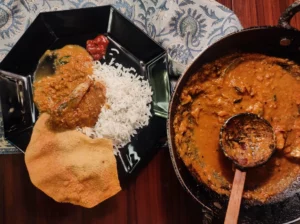
Granny’s meen curry (Sitara Cariappa)
Ingredients:
Fish: 8-10 pieces (use any kind of fish, even if it’s just tails and heads)
Oil: 1 tbsp
Mustard seeds: 1 tsp
Curry leaves: 2 sprigs
Green chili: 1, chopped (optional)
Chili powder: 1 tsp (optional)
Coriander powder: 2 tsp
Cumin powder: 1 tsp
Tamarind paste: 1 tbsp
Salt to taste
For fish marinade:
Kachampuli: 1/2 tsp
Salt: 1 tsp
Chilli powder: 1 tsp
Turmeric powder: 1/2 tsp
For chutney:
Oil: 2 tsp
Tomatoes: 2, chopped
Onions: 2 medium-sized, chopped
Dry red chilies: 4-5
Curry leaves: 1 sprig
Coconut: 1/2, ground to a paste
Chili: 1, green
Garlic cloves: 7-8
Ginger: 2″ stick, pound
Salt: 1 tsp
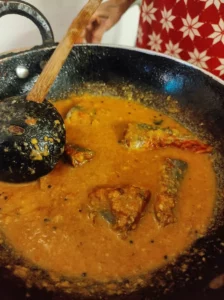
Stir in the pieces gently to immerse them in the curry. (Sitara Cariappa)
Method:
(Please note: In order not to break the fish, minimise the stirring frequency once added. Use spice as required.)

Apr 30, 2024

Apr 30, 2024

Apr 30, 2024

Apr 30, 2024

Apr 30, 2024

Apr 30, 2024